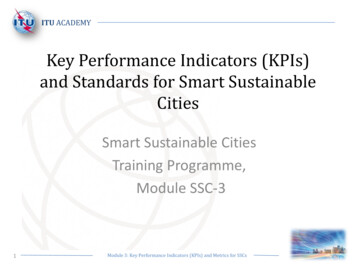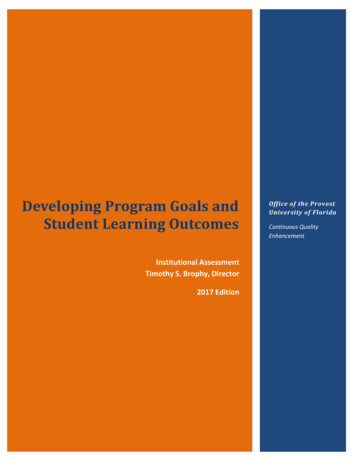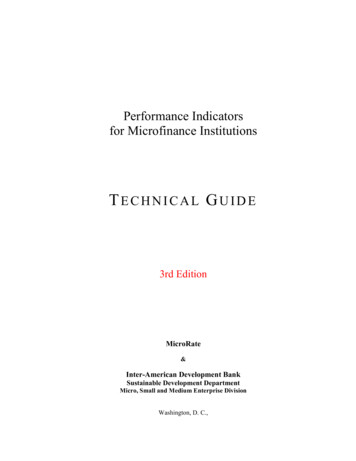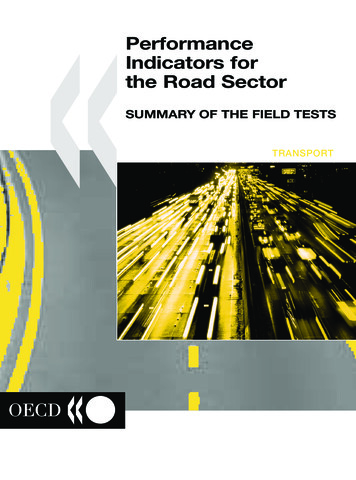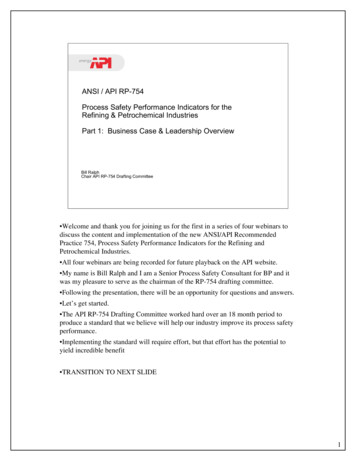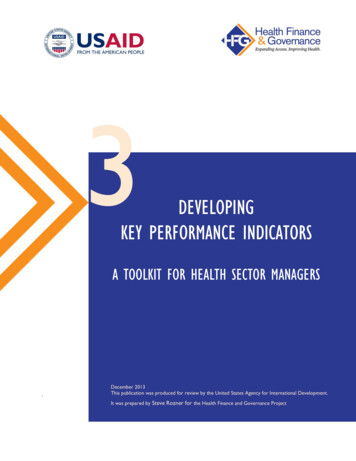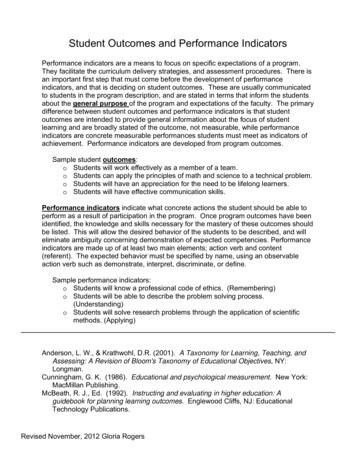
Transcription
Student Outcomes and Performance IndicatorsPerformance indicators are a means to focus on specific expectations of a program.They facilitate the curriculum delivery strategies, and assessment procedures. There isan important first step that must come before the development of performanceindicators, and that is deciding on student outcomes. These are usually communicatedto students in the program description, and are stated in terms that inform the studentsabout the general purpose of the program and expectations of the faculty. The primarydifference between student outcomes and performance indicators is that studentoutcomes are intended to provide general information about the focus of studentlearning and are broadly stated of the outcome, not measurable, while performanceindicators are concrete measurable performances students must meet as indicators ofachievement. Performance indicators are developed from program outcomes.Sample student outcomes:o Students will work effectively as a member of a team.o Students can apply the principles of math and science to a technical problem.o Students will have an appreciation for the need to be lifelong learners.o Students will have effective communication skills.Performance indicators indicate what concrete actions the student should be able toperform as a result of participation in the program. Once program outcomes have beenidentified, the knowledge and skills necessary for the mastery of these outcomes shouldbe listed. This will allow the desired behavior of the students to be described, and willeliminate ambiguity concerning demonstration of expected competencies. Performanceindicators are made up of at least two main elements; action verb and content(referent). The expected behavior must be specified by name, using an observableaction verb such as demonstrate, interpret, discriminate, or define.Sample performance indicators:o Students will know a professional code of ethics. (Remembering)o Students will be able to describe the problem solving process.(Understanding)o Students will solve research problems through the application of scientificmethods. (Applying)Anderson, L. W., & Krathwohl, D.R. (2001). A Taxonomy for Learning, Teaching, andAssessing: A Revision of Bloom's Taxonomy of Educational Objectives, NY:Longman.Cunningham, G. K. (1986). Educational and psychological measurement. New York:MacMillan Publishing.McBeath, R. J., Ed. (1992). Instructing and evaluating in higher education: Aguidebook for planning learning outcomes. Englewood Cliffs, NJ: EducationalTechnology Publications.Revised November, 2012 Gloria Rogers
COGNITIVE learning is demonstrated by knowledge recall and the intellectual skills: comprehending information, organizing ideas,analyzing data, applying knowledge, choosing among alternatives in problem-solving, and creation of new products or ideas.LevelIllustrative VerbsCategory DefinitionCognitive processesRememberArrange, Define, Describe, Duplicate, Identify,Label, List, Match, Name, Order, Outline, Recite,Recognize, Relate, Repeat, Reproduce, Select,State, Tabulate, Tellretrieve relevant knowledgefrom long-term memoryRecognizing (identifying), recalling(retrieving)UnderstandClassify, Compare, Compute, Convert, Contrast,Defend, Describe, Differentiate, Distinguish,Estimate, Explain, Extrapolate, Generalize,Interpolate, Locate, Paraphrase, Predict,Recognize, Review, Summarize, Translateconstruct meaning frominstructional messagesincluding oral, written andgraphical communicationInterpreting, exemplifying,classifying, summarizing, inferring,summarizing, comparingApplyApply, Change, Choose, Calculate, Classify,Demonstrate, Determine, Employ, Examine,Illustrate, Interpret, Modify, Operate, Practice,Predict, Prepare, Produce, Restructure, Schedule,Sketch, Solve, UseCarry out or use a procedurein a given situationExecuting, implementingAnalyzeAnalyze, Appraise, Break down, Calculate,Categorize, Compare, Contrast, Criticize, Debate,Diagram, Differentiate, Discriminate, Distinguish,Examine, Experiment, Indentify, Infer, Inventory,Relate, Separate, Subdivide, Testbreak material into itsconstituent parts anddetermine how the parts relateto one another and to anoverall structure or purposeDifferentiating, organizing, attributingEvaluateAppraise, Argue, Assess, Choose, Compare,Contrast, Criticize, Defend, Discriminate, Estimate,Evaluate, Explain, Interpret. Judge, Measure,Predict, Rank, Rate, Recommend, Select, Support,Validatemake judgments based oncriteria and standards throughchecking and critiquingChecking, critiquingCreateArrange, Assemble, Construct, Collect, Compose,Create, Design, Develop, Formulate, Integrate,Manage, Organize, Plan, Prepare, Prescribe,Produce, Propose, Specify, Synthesize, Writeputting elements together toform a coherent or functionalwhole; reorganizing elementsinto a new pattern or structureGenerating, planning, producingAnderson, Lorin (2001). A Taxonomy for Learning, Teaching, and Assessing: A Revision of Bloom's Taxonomy of Educational Objectives, NY: Longman.Gronlund, N. E. (1981). Measurement and evaluation in teaching, 4th ed. New York, Macmillan Publishing.McBeath, R. J., (Ed.). (1992). Instructing and evaluating in higher education: A guidebook for planning learning outcomes. Englewood Cliffs, NJ: Educational TechnologyRevised November, 2012 Gloria Rogers
AFFECTIVE learning is demonstrated by behaviors indicating attitudes of awareness, interest, attention, concern, and responsibility,ability to listen and respond in interactions with others, and ability to demonstrate those attitudinal characteristics or values which areappropriate to the test situation and the field of study.LevelIllustrative VerbsDefinitionExampleReceivingasks, chooses, describes, follows,gives, holds, identifies, locates, names,points to, selects, sits erect, replies,useswillingness to receive or attendlistening to discussions ofcontroversial issues with anopen mind, respecting therights of othersRespondinganswers, assists, complies, conforms,discusses, greets, helps, labels,performs, practices, presents, reads,recites, reports, selects, tells, writesactive participation indicatingpositive response oracceptance of an idea or policycompleting homeworkassignments, participating inteam problem-solving activitiesValuingcompletes, describes, differentiates,explains, follows, forms, initiates,invites, joins, justifies, proposes, reads,reports, selects, shares, studies, worksexpressing a belief or attitudeabout the value or worth ofsomethingaccepting the idea thatintegrated curricula is a goodway to learn, participating in acampus blood driveOrganizationadheres, alters, arranges, combines,compares, completes, defends,explains, generalizes, identifies,integrates, modifies, orders, organizes,prepares, relates, synthesizesorganizing various values intoan internalized systemrecognizing own abilities,limitations, and values anddeveloping realistic aspirationsCharacterization by avalue or value complexacts, discriminates, displays,influences, listens, modifies, performs,practices, proposes, qualifies,questions, revises, serves, solves,uses, verifiesthe value system becomes away of lifea person's lifestyle influencesreactions to many differentkinds of situationsGronlund, N. E. (1981). Measurement and evaluation in teaching, 4th ed. New York, Macmillan Publishing.McBeath, R. J., (Ed.). (1992). Instructing and evaluating in higher education: A guidebook for planning learning outcomes. Englewood Cliffs, NJ: Educational TechnologyPublications.Revised November, 2012 Gloria Rogers
PSYCHOMOTOR learning is demonstrated by physical skills: coordination, dexterity, manipulation, grace, strength, speed; actionswhich demonstrate the fine motor skills such as use of precision instruments or tools, or actions which evidence gross motor skills suchas the use of the body in dance or athletic performance.LevelIllustrative VerbsDefinitionExamplePerceptionchooses, describes, detects,differentiates, distinguishes,identifies, isolates, relates, selects,separatesusing sense organs to obtain cuesneeded to guide motor activitylistening to the sounds made by guitar stringsbefore tuning them, recognizing sounds thatindicate malfunctioning equipmentSetbegins, displays, explains, moves,proceeds, reacts, responds,snows, starts, volunteersbeing ready to perform aparticular action: mental, physicalor emotionalknowing how to use a computer mouse, havinginstrument ready to play and watching conductorat start of a musical performance, showingeagerness to assemble electronic components tocomplete a taskGuided responseassembles, builds, calibrates,constructs, dismantles, displays,dissects, fastens, fixes, grinds,heats, manipulates, measures,mends, mixes, organizes, sketchesperforming under guidance of amodel: imitation or trial and errorusing a torque wrench just after observing anexpert demonstrate a its use, experimenting withvarious ways to measure a given volume of avolatile chemicalMechanism(same list as for guided response)being able to perform a taskhabitually with some degree ofconfidence and proficiencydemonstrating the ability to correctly execute a60 degree banked turn in an aircraft 70 percentof the timeComplex or overtresponse(same list as for guided response)performing a task with a highdegree of proficiency and skilldismantling and re-assembling variouscomponents of an automobile quickly with noerrorsAdaptationadapts, alters, changes,rearranges, reorganizes, revises,variesusing previously learned skills toperform new but related tasksusing skills developed learning how to operatean electric typewriter to operate a wordprocessorOriginationarranges, combines, composes,constructs, creates, designs,originatescreating new performances afterhaving developed skillsdesigning a more efficient way to perform anassembly line taskGronlund, N. E. (1981). Measurement and evaluation in teaching, 4th ed. New York, Macmillan Publishing.McBeath, R. J., (Ed.). (1992). Instructing and evaluating in higher education: A guidebook for planning learning outcomes. Englewood Cliffs, NJ: Educational TechnologyPublications.Revised November, 2012 Gloria Rogers
Cognitive Levels, Terms and Assessment TaskGloria Rogers with Susan HatfieldHLC, February 2016Learning luationCreateLevel tructDesignFashionProduceAssessment TaskRemembering previous learned information:‐Complete multiple choice‐Fill in the blank‐Provide oral response‐Complete true/false‐Develop a list‐Choose among alternatives (could be a list)Grasping the meaning of Information previously presented:‐Give an analogy‐Create an outline‐Summarize in own words‐Create a concept map‐Draw a diagram‐Graph the answer‐Match term with a definitionUsing principle/formula/processes previously learned:‐Compute an answer‐Solve a problem similar to previous problems‐Solve a problem in a new setting‐Create a model‐Write an essay that requires the use of the concepts/processes learned‐Use theory or principle to explain an event or phenomenaBreaking down objects or ideas into simpler parts and seeing how theparts relate and are organized:‐Deconstruct a model‐Identify differences‐Group like items together‐Identify what is missing‐Identify cause and effect‐Perform a SWOT analysis‐Discuss an event/ perspective from multiple perspectives‐Present the potential impact resulting from a decision or choiceMaking judgments based on internal evidence or external criteria:‐Choose best among options and defend your choice‐Rank from best to worse using establish criteria‐Develop criteria for judgment and apply to a solution‐Recommend and defend choice for action‐Present the pros and cons of an approach‐Determine the degree of success or failure of an action or eventMaking or producing something based on previously learnedinformation and processes:‐Create an end‐of program capstone project‐Complete a summative class project‐Write a summative paper in a course‐Write an end‐of program thesis‐Write an end‐of program dissertation‐Design an original approach to a situation or problem‐Write a short story, poem, play‐Use a form of artistic expression to respond to an exigence‐Develop a curriculum that integrates multiple disciplines‐Conduct independent research
Adapted from:A Guide to Developing and Delivering Measurable Student Learning Outcomes(Canada College)How do I know if a performance indicator is well‐written?1. Does the performance indicator support the intended outcome?2. Does the performance indicator describe what students should know (cognitive), do(behavioral, performance), or think (affective, attitudinal)?3. Is the performance indicator:a. Specific?b. Measurable/identifiable?c. A result of learning?4. Do you have or can you create activities which enable students to learn the desiredperformance indicator?5. Is the performance indicator a “leading indicator” for the outcome?6. Can students’ demonstration on the performance indicator be used to make decisions onhow to improve the program?As a result of participating in the learning activity, students will be able to:(performance indicator) K.pdf
Examine, Experiment, Indentify, Infer, Inventory, Relate, Separate, Subdivide, Test break material into its constituent parts and determine how the parts relate to one another and to an overall structure or purpose Differentiating, organizing, attributing Evaluate Appraise, Argue, Assess, Choose, Compare,
